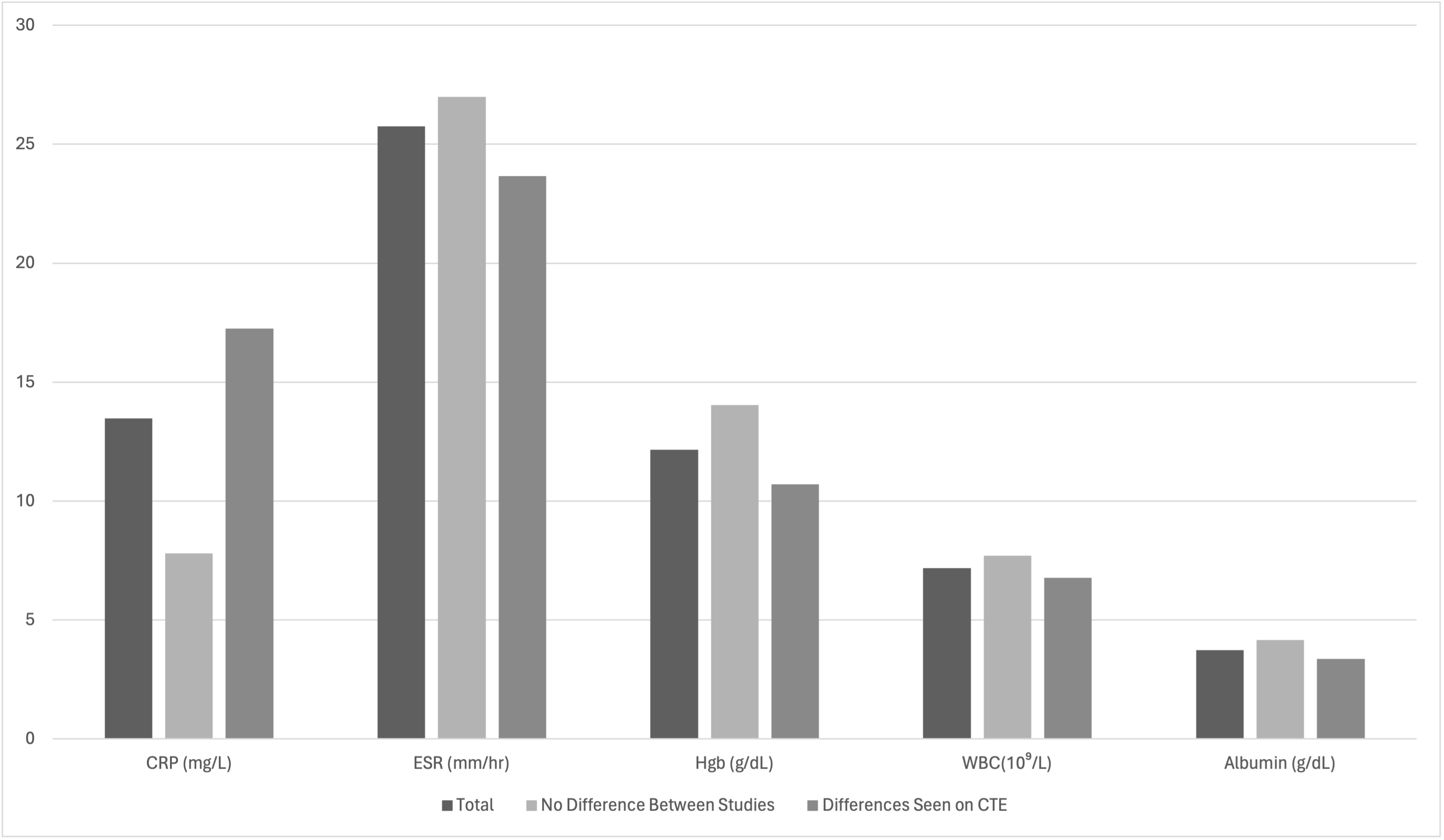Monday Poster Session
Category: IBD
P2564 - Comparing Findings of CT Abdomen Pelvis Followed by CT Enterography Scans Within 90 Days in Patients With Inflammatory Bowel Disease
Monday, October 28, 2024
10:30 AM - 4:00 PM ET
Location: Exhibit Hall E

Has Audio

Rachna Talluri, MD
University of Colorado Anschutz Medical Campus
Denver, CO
Presenting Author(s)
Rachna Talluri, MD1, Benjamin Click, MD2, Frank I.. Scott, MD, MSc(Epi)3, Waseem Ahmed, MD3, Blair Fennimore, MD3, Mark Gerich, MD3, Calen Steiner, MD3, Debbie Cheng, MD3
1University of Colorado Anschutz Medical Campus, Denver, CO; 2University of Colorado, Aurora, CO; 3University of Colorado Anschutz Medical Campus, Aurora, CO
Introduction: Computed tomography enterography (CTE) is an imaging protocol that can help identify small bowel manifestations of inflammatory bowel disease (IBD). CTEs can help guide clinical management, but a CT abdomen/pelvis (CTAP) may be obtained instead for IBD patients receiving more urgent care. Due to potential added information, providers may order a CTE shortly after CTAP with added radiation exposure and costs. Limited data exist regarding added yield with CTE after recent CTAP. This study aimed to determine the rate at which CTE performed within 90 days of a CTAP found added IBD-specific findings, and how often this led to changes in IBD management.
Methods: This was a retrospective observational study of adults with a diagnosis of IBD at a large tertiary referral center in the western US who received a CTAP and then CTE within 90 days. Data was collected from the electronic medical record by utilizing specific ICD codes and CPT codes. Data collected included disease and surgical history, medications, laboratory values at the time of CTs, and imaging details. Clinical differences between patients with no change and changes in CTs were compared using descriptive statistics.
Results: 16 IBD patients had a CTE within 90 days of a prior CTAP, with a median of 28 (11.5-45.8 IQR) days between studies. 9 (56%) had findings on CTE not seen on prior CTAP, of which 6 (67%) had stricturing or penetrating complications. 3 (33%) with changes seen on CTE then had medication changes, including adding budesonide, antibiotics, or biologics. C-reactive protein (CRP) and fecal calprotectin (FCP) were elevated in those with differences seen on CTE (see Figure 1). Differences seen on CTE were also associated with lower hemoglobin (Hgb) and albumin levels (see Figure 1). Formal statistical testing was not able to be completed given the limited sample size of this study.
Discussion: In this small exploratory study, 56% of IBD patients who had a CTE within 90 days following a CTAP had new findings seen and a subset led to medication changes. Given associations between specific laboratory values and patients with differences seen between studies, these markers could be used to identify those who may benefit from CTE. This study is limited by the small sample size along with inter-reader variability amongst radiologists. Further studies with larger patient populations will be required to identify if obtaining CTE within 90 days after CTAP provides clinically significant changes in patient care in IBD.

Note: The table for this abstract can be viewed in the ePoster Gallery section of the ACG 2024 ePoster Site or in The American Journal of Gastroenterology's abstract supplement issue, both of which will be available starting October 27, 2024.
Disclosures:
Rachna Talluri, MD1, Benjamin Click, MD2, Frank I.. Scott, MD, MSc(Epi)3, Waseem Ahmed, MD3, Blair Fennimore, MD3, Mark Gerich, MD3, Calen Steiner, MD3, Debbie Cheng, MD3. P2564 - Comparing Findings of CT Abdomen Pelvis Followed by CT Enterography Scans Within 90 Days in Patients With Inflammatory Bowel Disease, ACG 2024 Annual Scientific Meeting Abstracts. Philadelphia, PA: American College of Gastroenterology.
1University of Colorado Anschutz Medical Campus, Denver, CO; 2University of Colorado, Aurora, CO; 3University of Colorado Anschutz Medical Campus, Aurora, CO
Introduction: Computed tomography enterography (CTE) is an imaging protocol that can help identify small bowel manifestations of inflammatory bowel disease (IBD). CTEs can help guide clinical management, but a CT abdomen/pelvis (CTAP) may be obtained instead for IBD patients receiving more urgent care. Due to potential added information, providers may order a CTE shortly after CTAP with added radiation exposure and costs. Limited data exist regarding added yield with CTE after recent CTAP. This study aimed to determine the rate at which CTE performed within 90 days of a CTAP found added IBD-specific findings, and how often this led to changes in IBD management.
Methods: This was a retrospective observational study of adults with a diagnosis of IBD at a large tertiary referral center in the western US who received a CTAP and then CTE within 90 days. Data was collected from the electronic medical record by utilizing specific ICD codes and CPT codes. Data collected included disease and surgical history, medications, laboratory values at the time of CTs, and imaging details. Clinical differences between patients with no change and changes in CTs were compared using descriptive statistics.
Results: 16 IBD patients had a CTE within 90 days of a prior CTAP, with a median of 28 (11.5-45.8 IQR) days between studies. 9 (56%) had findings on CTE not seen on prior CTAP, of which 6 (67%) had stricturing or penetrating complications. 3 (33%) with changes seen on CTE then had medication changes, including adding budesonide, antibiotics, or biologics. C-reactive protein (CRP) and fecal calprotectin (FCP) were elevated in those with differences seen on CTE (see Figure 1). Differences seen on CTE were also associated with lower hemoglobin (Hgb) and albumin levels (see Figure 1). Formal statistical testing was not able to be completed given the limited sample size of this study.
Discussion: In this small exploratory study, 56% of IBD patients who had a CTE within 90 days following a CTAP had new findings seen and a subset led to medication changes. Given associations between specific laboratory values and patients with differences seen between studies, these markers could be used to identify those who may benefit from CTE. This study is limited by the small sample size along with inter-reader variability amongst radiologists. Further studies with larger patient populations will be required to identify if obtaining CTE within 90 days after CTAP provides clinically significant changes in patient care in IBD.

Figure: Figure 1. Laboratory differences between IBD patients with no difference and difference between CTAP and CTE
Note: The table for this abstract can be viewed in the ePoster Gallery section of the ACG 2024 ePoster Site or in The American Journal of Gastroenterology's abstract supplement issue, both of which will be available starting October 27, 2024.
Disclosures:
Rachna Talluri indicated no relevant financial relationships.
Benjamin Click: AbbVie – Consultant. BMS – Consultant. Janssen – Consultant. Pfizer – Consultant. Prometheus – Consultant. Takeda – Consultant. TARGET-RWE – Consultant.
Frank Scott: Crohn's and Colitis Foundation – Grant/Research Support. Takeda Pharmaceuticals – Grant/Research Support.
Waseem Ahmed indicated no relevant financial relationships.
Blair Fennimore indicated no relevant financial relationships.
Mark Gerich indicated no relevant financial relationships.
Calen Steiner indicated no relevant financial relationships.
Debbie Cheng indicated no relevant financial relationships.
Rachna Talluri, MD1, Benjamin Click, MD2, Frank I.. Scott, MD, MSc(Epi)3, Waseem Ahmed, MD3, Blair Fennimore, MD3, Mark Gerich, MD3, Calen Steiner, MD3, Debbie Cheng, MD3. P2564 - Comparing Findings of CT Abdomen Pelvis Followed by CT Enterography Scans Within 90 Days in Patients With Inflammatory Bowel Disease, ACG 2024 Annual Scientific Meeting Abstracts. Philadelphia, PA: American College of Gastroenterology.
